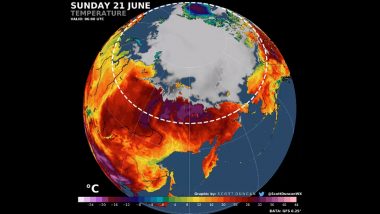While the lockdown of months may have improved a lot of positive and significant changes in nature across the world, a piece of not so good news comes from Arctic Circle. A Siberian Town of Verkhoyansk has recorded the highest temperature of 38 degrees celsius or 100.4 Fahrenheit on Saturday, June 20. This is the highest ever temperature in history recorded at the Arctic Circle, almost 20 degrees more from what is normally expected at this point of the year. Arctic Circle Oil Spill in Russia: What Caused the Oil Spill? How Long Will It Take to Clean Up the Spill? All FAQs Answered Here (View Pics and Videos).
Verkhoyansk inside the Arctic Circle at 67.5°N, which is 4828 kilometres east of Moscow is known for having the most diverse temperatures in the world. Just last year in November, this town recorded winter temperatures plunging to -55 degrees. The Arctic region is experiencing a heatwave at the moment and the current rising temperatures are a cause of that. It is a reason to worry as much of Siberia is now seeing an outbreak of wildfires in the area. According to a report, the temperatures on Sunday were also at 35 degrees.
Check Video of the Rising Temperature Record in The Artic:
It is not just Northern Russia in the furnace. Let's head over to Canada and take a look...
Temperatures over +30 °C will spread north of the Arctic Circle line - north of the semi frozen Hudson Bay.
Islands of Nunavut and Northwest Territories will be baking hot. pic.twitter.com/RipK4mEW94
— Scott From Scotland (@ScottDuncanWX) June 19, 2020
The normal temperatures of summer in the region are supposed to be around 20 degrees celsius. The latest rise in temperature signifies global warming is occurring here at twice the rate. The Arctic Circle also made it to the news at the start of the month when a massive oil spill took place near the city of Norilsk. The waters in the river turned red, which netizens saw as a sign of apocalyptic times. Global warming is a long-term problem that the entire world is facing but the rate of it seems to have doubled in the Siberian region which is a major cause of worry. It also puts the habitat of plants and animals that survive in the cold weathers here at risk.
(The above story first appeared on LatestLY on Jun 22, 2020 04:49 PM IST. For more news and updates on politics, world, sports, entertainment and lifestyle, log on to our website latestly.com).













 Quickly
Quickly




















